Life on Land, Elementary School Science Projects (57 results)
The United Nations Sustainable Development Goals (UNSDGs) are a blueprint to achieve a better and more sustainable future for all.
These projects explore topics key to Life on Land: Sustainably manage forests, combat desertification, halt and reverse land degradation, halt biodiversity loss.
These projects explore topics key to Life on Land: Sustainably manage forests, combat desertification, halt and reverse land degradation, halt biodiversity loss.
Science Buddies' elementary school science projects are the perfect way for elementary school students to have fun exploring science, technology, engineering, and math (STEM). Our elementary school projects are written and tested by scientists and are specifically created for use by students in the elementary school grades. Students can choose to follow the science experiment as written or put their own spin on the project.
For a personalized list of science projects, elementary schoolers can use the Science Buddies Topic Selection Wizard. The wizard asks students to respond to a series of simple statements and then uses their answers to recommend age-appropriate projects that fit their interests.
|
Select a resource
Coding Projects
Sort by
|
Have you ever seen a (non-carnivorous) plant eat? Probably not! Plants do not get the energy they need from food, but from the sunlight! In a process called photosynthesis, plants convert light energy, water, and carbon dioxide into oxygen and sugar. They can then use the sugar as an energy source to fuel their growth. Scientists have found an easy way to measure the rate of photosynthesis in plants. The procedure is called the floating leaf disk assay. In this plant biology project, you can…
Read more
In the wild there are two types of animals: the hunters and the hunted. A good predator is always on the prowl for fresh prey. What can an animal do to stay off of the menu? Some animals have evolved to use a variety of camouflage tactics so they can fool their predators and increase their chances of survival. In this science project, you will be the hungry predator hunting for M&M® prey. But it may not be as easy as it sounds — some of your prey will be camouflaged. Will they be…
Read more
New
Have you ever walked next to your favorite ocean, lake, or creek and seen plastic waste everywhere? Have you ever thought about how much plastic breaks down into microplastics and pollutes waterways? Scientists are coming up with new ways to remove these microplastics from our waterways, and now you can test them out for yourself at home.
Read more
Have you ever heard someone say, "that plant is thirsty" or "give that plant a drink of water"? We know that plants, and even bouquets of cut flowers, need water to survive, but have you ever thought about how the water moves within the plant? In this science project, you will use colored water and carnations to figure out where the water goes.
Read more
Have you ever seen butterflies fluttering around outside, gliding through the air and landing on flowers? While they are delicate and fragile, butterflies are actually excellent flyers. They are so good, in fact, that scientists at Harvard University studied butterfly wing shapes as an inspiration for building a miniature flying robot. In this science project, you will do your own version of the Harvard scientists' experiment to measure the flight performance of butterfly wings.
Read more
How do you tell the difference between a bird and a fish? Birds tend to have feathers and can fly, while fish have no legs and can breathe underwater. In this project, you will explore how to create a decision tree using machine learning that can classify different animals based on multiple characteristics. This project is designed for beginners and requires little to no coding experience. Ready to give it a shot?
Read more
New
Have you ever seen a waiter balance an entire tray of drinks without spilling any? How do they do it? Do you think you could build a robot waiter that can do the same thing? In this project, you will learn how to build a self-balancing robotic tray. You can incorporate the auto-leveling tray into one of our many other robotics projects, like the Bluebot or robotic arm.
Read more
Have you ever wondered how a chick breathes inside its shell? Every animal needs oxygen to survive, so the chick must get air somehow! Try this science project to discover the answer.
Read more
Up, up, and away! If you have ever made a wish and blown the fluff of a dandelion, you have witnessed how some plants are adapted to spreading their seeds using the wind. The tiny, furry parachute allows the seeds to be picked up by the wind and to be carried far away from their parent plant. In this experiment, you will make models of seeds and fruit to investigate dispersal by wind and to evaluate
the relationship between the structure of the seed and its ability to be dispersed by the…
Read more
Animals survive in all sorts of extreme environments, whether it is a polar bear out and about when it is -40°F, a desert iguana trying to find food as the temperature rises to 110°F, or a deep sea anglerfish living 3281 feet down into the sea. How do they do it? The answer is adaptations! Their bodies have special features that allow them to live in those environments. You might not be able to dive down 3281 feet to observe the deep sea anglerfish, but in this science fair project you…
Read more
In this fun science project, you will create a bird feeder from recycled materials that you can set up outside. By observing the birds that come to the bird feeder, you will find out what different kinds of birds live in your area. How many different kinds of birds do you think you will spot?
Read more
To be able to live on Mars, humans need breathable air, clean water, and nutritious food. Spacesuits can provide oxygen to breathe, ice on Mars can be a source of water, but how could we get nutritious food? Today's astronauts bring food with them. But a manned trip to Mars would require food that was either successfully grown in space or on Mars, as taking the extra weight of food for such a long time—it takes 6–9 months one way—is just too costly. In this project, you will…
Read more
|

















